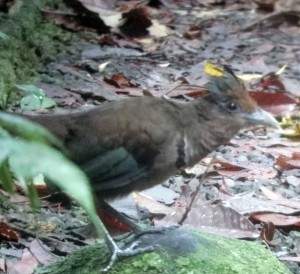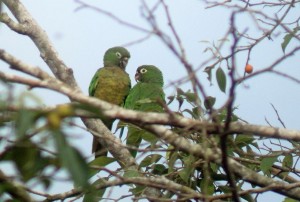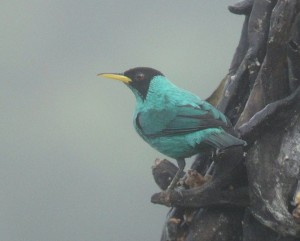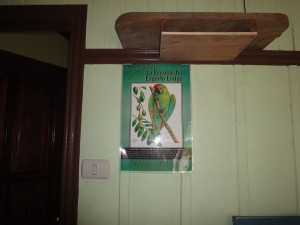5 AM, September 8th, Laguna del Lagarto
Whether guiding a trip like this one or out birding for fun, I’m always out in the field by dawn. On this day, I ventured outside when it was still dark to listen for migrants. None were heard and the owls were quiet (of the 6 or 7 species present at this site) but some of the other birds that typically call in the crepuscular hours were revealing themselves. A couple of Green Ibis gave their odd, growling calls from one of the lagoons as a Collared Forest Falcon called from the forest. The sounds of woodcreepers also signal dawn when birding in Costa Rica and Laguna was no exception with Northern Barred, Streak-headed, Cocoa, and Black-striped all sounding off. Rufous-tailed and Scaly-breasted Hummingbirds were also coming awake with squeeky sounding calls.
It was light enough to see in a matter of minutes and as I walked over to the essential morning cup of coffee, pairs of Red-lored Parrots began to call and fly overhead. Small flocks of Olive-throated and Crimson-fronted Parakeets were also seen and more of the same species from yesterday were chipping from the trees and coming down to the feeder.
After that first cup of coffee, we decided to head back to the garden to relocate the Pied Puffbirds from the previous evening and try once again for White-fronted Nunbird. Despite calling for them in the same place where we had seen them, the puffbirds pulled a now-show. As for their orange-billed cousins, forget about it. They were nowhere to be seen or heard. Nor did Central American Pygmy-Owl vocalize or reveal itself- they might be quiet at that time of the year. So, after the garden we checked the compost heap to see if something rare like an Olive-backed Quail-Dove happened to be foraging for easy pickings. That wasn’t to be but we were at least entertained by a family of funny looking Gray-necked Wood-Rails.
When we passed by the entrance to the trails, the group also got fantastic looks at a pair of Great Curassows! These large, fancy Cracids are very rare or gone from many parts of their accessible range due to an unfortunate inability to withstand just about any amount of hunting. Luckily, in Costa Rica, they are fairly easy to see at a few lodges and sites where they receive enough protection.
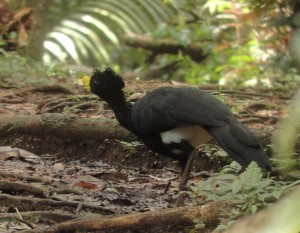

One can never get enough of those curly-crested Great Curassows.
After the curassows displayed their greatness and walked off into the leafy understory, we ventured out onto the road that goes in front of the lodge. With forest on one side and open areas on the other, it offers exciting opportunities for a huge variety of birds.

View of lowland rainforest and one of the lagoons from the road.
We quickly got onto more Olive-throated Parakeets, and saw typical lowland fare like toucans, Collared Aracari, Yellow Tyrannulet, tityras, Shining Honeycreepers, White-vented Euphonia, Short-billed Pigeons, and other species. Our best bird was arguably the cool-looking Scaled Pigeon that perched high up in an isolated tree near a couple of Short-billeds. Ironically, the Scaled has much more of a red-colored bill than the Red-billed Pigeon but I admit that it’s pretty darn scaly too. Not long after the Scaled Pigeon, the time came to head back to the lodge for a true breakfast of Gallo Pinto (rice and beans), eggs, fruit, toast, and most importantly, more coffee.
While half of the group rested up after breakfast or canoed in one of the lagoons to search for the Agami Heron, I led the other half into the forest. As is typical of mid-morning in lowland rainforest, the low bird activity was far more conducive for studying plants. Not that we did that, but it would have been wonderful if a botanist could have accompanied us.

We could have learned about beautiful trees like these.

Or this one with me doing the requisite photo of standing in front of an old growth rainforest giant.
It was a beautiful walk in those humid, hallowed green halls but plants weren’t the only things we saw. Our patience and careful observation eventually paid off with views of Western Slaty Antshrike, Streak-crowned Antvireo, White-flanked and Checker-throated Antwrens, and Tawny-faced Gnatwren. All of these except for the antshrike were moving together in a small mixed flock. The calls of the gnatwren gave them away and it took a while for the others to come into view but they eventually did and we all got pretty good looks at these uncommon rainforest species.
After the mixed flock, we heard but only got glimpses of Tawny-crested Tanager and became excited upon seeing army ants (!). I heard a Bicolored Antbird and figured that we were in store for some antbird action but just couldn’t locate the front of the swarm. Nevertheless, we at least got some brief looks at a fancy Ocellated Antbird just before walking out of the forest to avoid a downpour.
Back at the lodge, Connie showed us what they saw from the boat- in addition to seeing the Agami Heron, they also saw a roosting Crested Owl! Off several of us went on a short yet fateful expedition in search of those quality birds. Although the sun was shining when we boarded the boats, this turned out to be nothing but a ruse that ended up soaking us to the core. At least the rain was warm and we saw both the heron and the owl but tragedy struck when my digital recording device got wet. It can play vocalizations in its memory banks but appears to no longer be capable of making recordings. I hope I can fix it soon!

The fateful canoe ride.
The rest of our birding on Saturday took place on the balcony, from a boat on the San Carlos river for some of the group, and during another walk in the forest. No tinamous and no responses from Tawny-faced Quail but it was a nice walk anyways and that evening, some of us got very close looks at Short-tailed Nighthawk doing its big bat impression just off the balcony and saw a flyover Green Ibis. No further luck with nocturnal birds that night and most of us crashed by about 8.
5AM, September 9th, Laguna del Lagarto
Another dawn walk turned up the same species as the day before. After coffee, we decided to bird down the front road again but this time, heading back towards Boca Tapada. This part of the road is forested on both sides and has a couple of wetlands. Things were pretty quiet and we skunked out on the nunbirds once again but still managed to see Black-throated Trogon, perched Mealy Parrot, toucans, Dot-winged Antwrens, Lesser Greenlets, and called in a Black-capped Pygmy-Tyrant that was missed by most because it’s basically a bug with feathers.
More lines of army ants were found right on the road and we could hear both Bicolored and Ocellated Antbirds but much to our frustration, we couldn’t close enough to the forest edge to see them! Nor would those denizens of the shady forest understory even come close to the edge. Plain-brown and Northern Barred Woodcreepers ventured into view though and most of us got looks at those ant-following birds.
After the swarm, it was time to head back to the lodge for breakfast and to do the bird list for the trip. With a longish drive ahead of them, everyone except Susan and I left for home. We decided to go for another walk in the forest to look for those elusive ground birds (can you tell that I need the quail for a lifer? I heard it in Ecuador once but the only ones we heard on this trip were the quail whistles from my own puckered lips). It was a beautiful walk in the forest in any case and the back area in particular looks really good. If you visit, I suggest walking straight back into the forest before dawn and hanging out there deep in the woods as it gets light. It might offer your best chance at getting birds like Slaty-backed Forest-Falcon, that elusive little quail, Tapir or even Jaguar. I can’t wait to try that on my next visit.

Looking up into the canopy.
We eventually ran into some birds and the calls of Tawny-crowned Greenlet, Tawny-faced Gnatwren, and Yellow-margined Flycatcher hinted at a mixed flock deep in the forest but our best find was of the reptile variety. Right next to the trail was a medium-sized Boa Constrictor. After giving it a healthy detour, I digiscoped its head.

Boa Constrictor at Laguna del Lagarto.
Upon leaving the forest, an adult Ornate Hawk Eagle called and soared above the parking lot (of course after everyone had hit the road). We packed and began the four and a half hour drive back. Sunny weather made for few birds along the way but we did manage to find out where the Great Green Macaws were! Just as we approached San Miguel, we counted a group of 33 of these majestic endangered birds as they flew near the base of the first mountain ridge from south to north around 3:00 PM. To me, it looked like they were making a beeline for Chilamate or the La Virgen area.
To sum the experience up, Laguna delivered pretty much just as it did a year and a half ago. Rooms were nice and clean, service was pretty much outstanding and food was pretty good. As for the birds, not as many came to the feeders (it’s better during January to April), and that time of the year is also better for Great Green Macaw but we still had a great selection of birds. Everyone got to see Agami Heron from a canoe, most saw the roosting Crested Owl, antwrens and antbirds were nice, we had 7 species of woodcreepers (Spotted was heard only), Pied Puffbird, close looks at Great Curassow and Slate-colored Grosbeak, Bat Falcon (two in our group saw it snatch a bat!), Ornate Hawk-Eagle for Susan and I, Scaled Pigeon, thousands of migrating Mississippi Kites, White-vented Euphonias, a very likely Green and Rufous Kingfisher glimpsed by Susan, and wonderful looks at parrots and parakeets. My only complaint is that I wish I could stay at least a week because when you spend just two nights at rich, lowland sites like Laguna del Lagarto, you barely scratch the surface.
On a side note, a four-wheel drive vehicle would be best for the road to the lodge.
To see more information about birds and birding in Costa Rica, see Costa Rica Living and Birding at http://birdingcraft.com/wordpress



